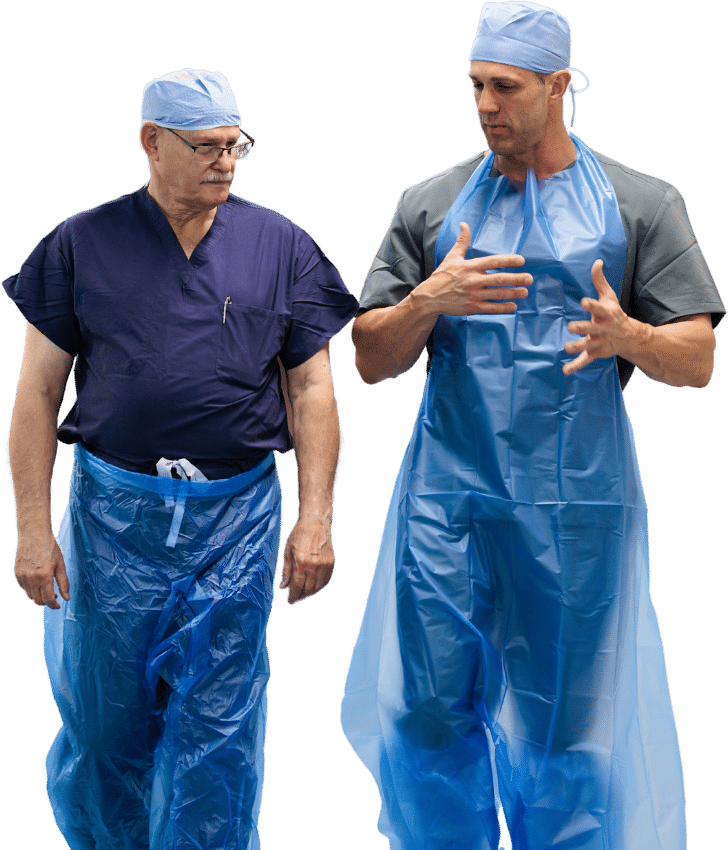Purchasing managers in hospitals, healthcare facilities, and surgical facilities play a critical role in ensuring the safety and well-being of their staff. When it comes to purchasing personal protective equipment (PPE) and disposable protective clothing, you have a lot of options. What are the key factors to focus on when stocking your PPE supplies?
First and foremost, purchasing managers need to assess the specific needs of their facility. This includes evaluating the types of procedures and tasks that staff members will be performing, as well as the potential hazards they may encounter. Understanding these factors will help determine the types of PPE and disposable protective clothing that are necessary to keep staff safe.
Next, purchasing managers must also consider the quality and reliability of the PPE and disposable protective clothing being purchased. Other important factors to consider include cost-effectiveness, comfort and fit, and the availability of necessary sizes and quantities.
Types of Personal Protective Equipment & Garments
In healthcare facilities, your staff will use different types of personal protective equipment (PPE) to protect themselves against bodily fluids and blood. Beyond gloves, masks, and face shields, surgical centers and emergency departments need special PPE to protect shoes, clothing, and skin from bodily fluids and bloodborne pathogens. This additional PPE is known as Protective Clothing or Protective Garments, and includes things like:
– Shoe covers
– Surgical knee-highs
– Surgical leggings
– Medical jumpsuits
– Surgical pant protectors
– Surgical aprons
– Protective coveralls
All of these are worn to protect the clothing, shoes, and skin of healthcare workers from being contaminated with bodily fluids and blood, and they’re an important part of your hospital safety strategy. Healthcare workers should receive training on the proper use and disposal of PPE to ensure their safety and the safety of their patients.
How to Select Protective Clothing for Protection Against Pathogens
When selecting protective clothing for healthcare facilities, the Centers for Disease Control and Prevention (CDC) recommends considering the following factors to ensure protection against microorganisms in blood and body fluids:
1. Material: Choose clothing made of fluid-resistant or impermeable materials to provide a barrier against microorganisms.
2. Fit: Ensure that the clothing fits properly to minimize gaps through which microorganisms could enter.
3. Durability: Select clothing that is durable and can withstand the activities and movements healthcare workers perform.
4. Comfort: Provide clothing that is comfortable to wear for extended periods to encourage proper use.
5. Accessibility: Ensure the clothing is easy to put on and take off to facilitate proper use and prevent contamination.
According to the CDC, healthcare workers face the risk of exposure to bloodborne pathogens, with an estimated 385,000 needlestick injuries occurring annually in the United States.
In addition, the presence of body fluids containing microorganisms poses a risk of transmission to healthcare workers. Therefore, selecting the appropriate protective clothing is essential in preventing exposure and maintaining a safe healthcare environment.
The Standards and Specifications You Should Know
The current standards and specifications for healthcare protective clothing and PPE are set by the Occupational Safety and Health Administration (OSHA) and the National Institute for Occupational Safety and Health (NIOSH).
Some key standards and specifications for healthcare protective clothing and PPE include:
– Gloves: Gloves must meet the American Society for Testing and Materials (ASTM) standards for barrier performance and quality.
– Gowns and protective coveralls: Gowns and protective coveralls must meet the Association of the Advancement of Medical Instrumentation (AAMI) standards for barrier protection and performance.
– Respiratory protection: Respirators must meet NIOSH standards for filtration efficiency and fit.
Healthcare facilities need to ensure that all healthcare protective clothing and PPE meet these standards to protect the health and safety of their workers.
Reusable PPE Garments Vs. Disposable PPE Garments
It’s important to choose the right protective clothing for keeping staff and patients safe. Two common options are reusable PPE and disposable protective clothing:
Disposable protective clothing:
– Keeps staff and patients safe by preventing the spread of harmful germs and bacteria.
– Is designed for one-time use, making it convenient and reducing the risk of contamination.
– Can be easily disposed of after each use, reducing the chance of cross-contamination.
– Provides a high level of protection when used properly.
Reusable PPE:
– Can be reused multiple times, reducing waste and environmental impact.
– May require additional cleaning and maintenance to ensure proper protection.
– Should be carefully inspected for any signs of wear and tear before each use.
While disposable protective clothing offers convenience and reduced risk of contamination, reusable PPE helps reduce waste and may lighten your environmental impact. It’s important to consider the specific needs of your healthcare facility when choosing the right protective clothing.
Comparing Reusable Vs. Disposable PPE Garments
When it comes to choosing between reusable and disposable personal protective equipment (PPE) garments, it’s important to consider the intended use and level of protection needed.
Reusable PPE garments used in medical settings feature a densely woven fabric such as pima cotton with a thread count of at least 270 or a very tightly-woven 100% polyester fabric. (int-enviroguard.com) Both cotton and polyester are absorbent materials, and PPE garments in these materials are likely to hold bodily fluids and blood in their fibers if exposure occurs.
Reusable PPE is generally appropriate for:
– Low-risk, non-hazardous tasks in primary healthcare facilities
– Routine use in non-clinical settings
– Situations where frequent changes are not necessary
Reusable PPE Pros:
– Environmentally friendly
– Cost-effective for long-term use
– Can be more comfortable to wear
Reusable PPE Cons:
– May require additional cleaning and maintenance
– Risk of cross-contamination if not properly sanitized
– Not suitable for most procedures in surgical centers or emergency departments.
On the other hand, disposable PPE garments should be made from non-absorbent, breathable, lightweight material. For example, Sloan Medical creates our premium STA-DRI line from a fluid-impervious 2 ml polyethylene blend that meets ASTM F1671 test standards.
Disposable PPE is better for:
– Moderate-risk or high-risk, hazardous tasks
– Medical or clinical settings
– Situations where frequent changes are required for infection control
Disposable PPE Pros:
– Convenient and easy to use
– Provides consistent protection
– Premium options minimize the risk of cross-contamination and exposure to bodily fluids or bloodborne pathogens within 2 droplets.
Disposable PPE Cons:
– Generates waste and contributes to environmental impact
– Bargain options may not be as comfortable to wear for extended periods
The Hidden Costs of Reusable PPE Garments
On the face of it, reusable options may seem better for the environment and your budget. However, there are hidden costs associated with reusable PPE garments that are often overlooked:
– Washing and maintenance: Reusable garments require regular washing and maintenance, which can add up in terms of water, energy, and detergent costs.
– Replacement and repair: Over time, reusable garments may become damaged and need to be replaced or repaired, costing additional money.
– Storage and inventory management: Properly storing and managing a large inventory of reusable garments can also be costly in terms of space and labor.
A study by the American Journal of Infection Control found that the use of reusable isolation gowns resulted in a higher cost per use compared to disposable gowns due to the additional costs of laundry and repair.
It’s important to consider all of these hidden costs when deciding between reusable and disposable PPE garments to make an informed decision. Studies have shown that proper selection of protective clothing can reduce the risk of contamination and improve overall safety for healthcare workers (Smith et al., 2015). This, in turn, impacts morale and turnover in your facility.
Choose Ultrasonically Welded Seams or “Heat Sealed” Seams
Seam construction is important. Whether you’re choosing disposable or reusable PPE garments, ultrasonically welded seams, also known as heat-sealed seams, are superior to stitched seams for several reasons.
First, ultrasonically welded seams create a stronger bond compared to stitched seams. According to a study by the Journal of the Textile Institute, ultrasonically welded seams have been shown to have higher tensile strength and are more resistant to tearing compared to stitched seams.
Additionally, heat-sealed seams provide a barrier that is impermeable to liquids and particles, reducing the risk of contamination. The Occupational Safety and Health Administration (OSHA) recommends the use of disposable PPE garments with ultrasonically welded, or heat-sealed, seams for workers who are at risk of exposure to infectious materials, bodily fluids, and bloodborne pathogens.
Lastly, ultrasonically welded seams are more comfortable to wear, as they eliminate the need for stitches that can cause irritation and discomfort to the wearer.
Choose a North American Supplier
Regardless of the PPE type you select, purchasing managers at hospitals and surgical centers in the United States should choose a manufacturer and supplier based in North America for several important reasons:
1. Quality and Safety: North American suppliers adhere to strict regulations and standards, ensuring high-quality and safe PPE for healthcare workers.
2. Faster Delivery: By choosing a supplier located in North America, hospitals can expect faster delivery times compared to suppliers located overseas. This is crucial during times of high demand or in emergencies.
3. Supports Local Economies: Supporting North American suppliers helps to strengthen the local economy and create jobs within the healthcare supply chain.
4. Reduced Risk of Supply Chain Disruptions: Working with a supplier in North America decreases the risk of supply chain disruptions caused by international shipping delays, shutdowns, and trade restrictions.
Prioritize choosing a PPE supplier based in North America to ensure the best quality and steady availability for your facility.
Stocking the Right PPE for Your Facility
Purchasing managers in hospitals and surgical facilities are, in many ways, the first line of defense when it comes to infection control. By selecting the right PPE, you can help guarantee the safety and well-being of your staff and patients.
Whether you’re exploring all your options or ready to try disposable PPE garments instead of the reusable PPE in your facility today, we’re here to help.Sloan Medical manufactures the highest quality PPE with a full line of STA-DRI products designed for maximum comfort and impervious protection. It’s what your medical staff deserves. Request a FREE sample to experience the Sloan difference.





